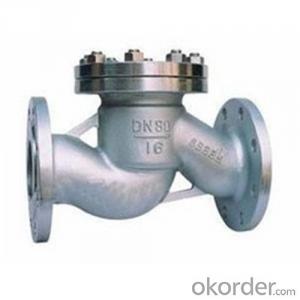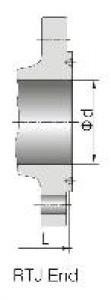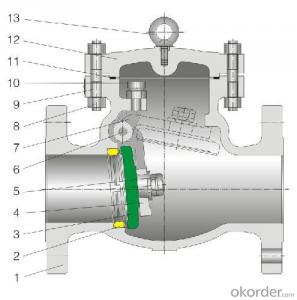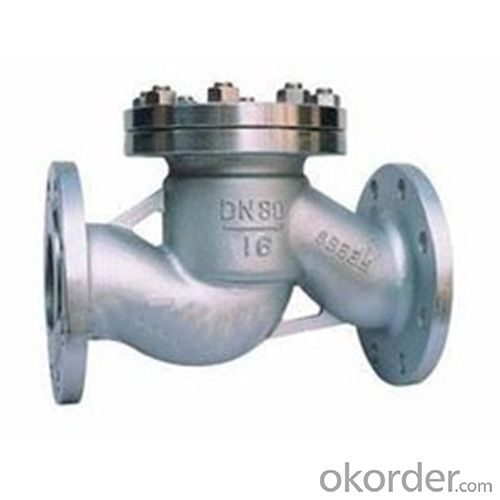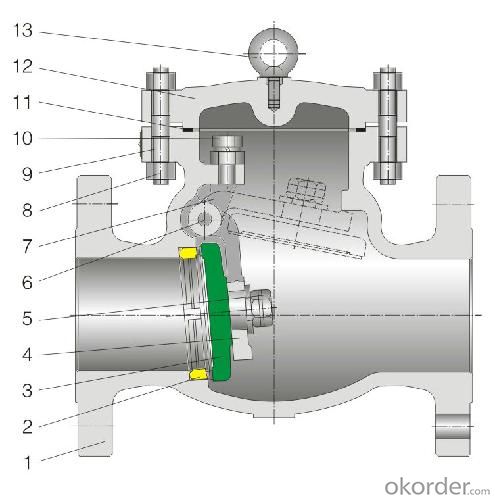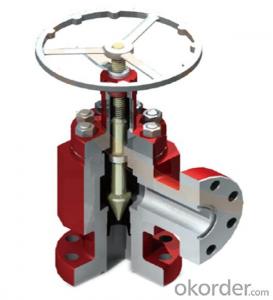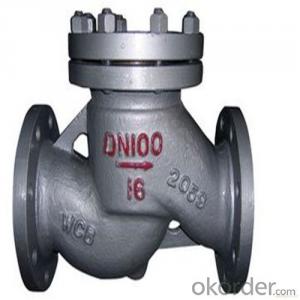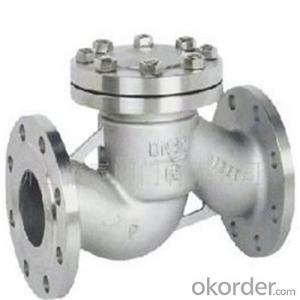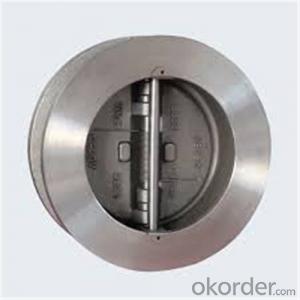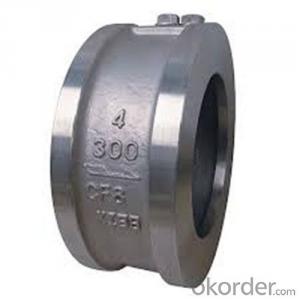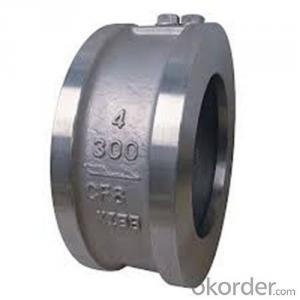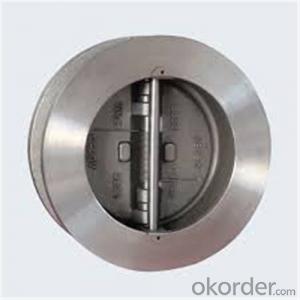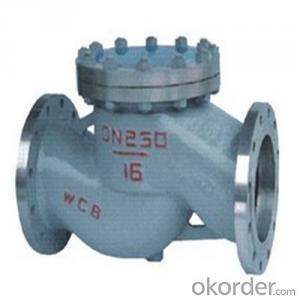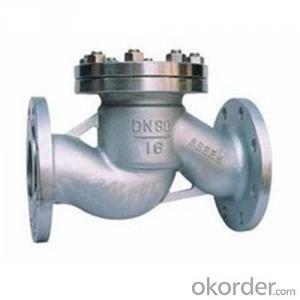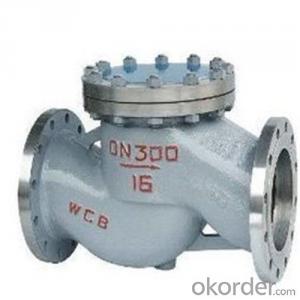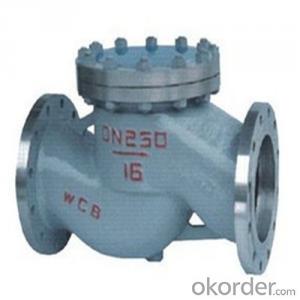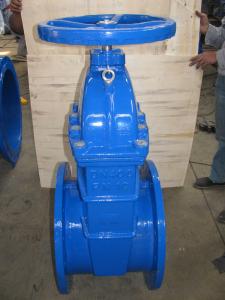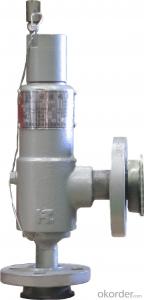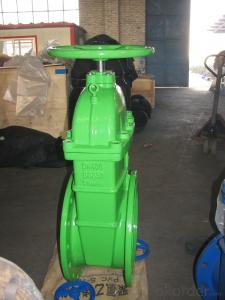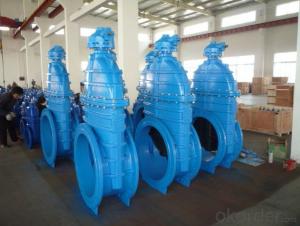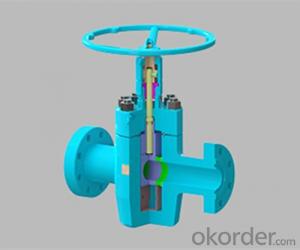API Cast Steel Lift Check Valve Size 650 mm
- Loading Port:
- Shanghai
- Payment Terms:
- TT OR LC
- Min Order Qty:
- 10 pc
- Supply Capability:
- 100 pc/month
OKorder Service Pledge
OKorder Financial Service
You Might Also Like
API Cast Steel Lift Check Valve 150 Class
The features of Cast Steel Lift Check Valve
Bolted Bonnet;Swing and lift disc;Metallic seating surfaces.
Body and Bonnet Connection of Cast Steel Lift Check Valve:
The body and bonnet of Class150~Class900 check valves are usually with studs and nuts.And the body and bonnet of Class1500~Class2500 check valves are usually of pressurized seal design.
Body-To-Bonnet Joint of Cast Steel Lift Check Valve:
Stainless steel + flesible graphite wounded gasket is used for Class 150 and Class 300 check valve;Stainless steel + flexible graphite wounded gasket is used for Class 600 check valve,and joint gasket is also optional for Class 600 check valve;Ring joint gasket is used for Class900 check valve;Pressurized seal design is used for Class 1500~Class 2500 check valves.
Seat of Cast Steel Lift Check Valve:
For carbon steel check valve,the seat is usually forged steel.The sealing surface of the seat is spray welded with hard alloy specified by the customer.Renewable threaded seat is used for NPS<10 check="" valves="" and="" welded="" on="" seat="" can="" be="" also="" optional="" if="" being="" requested="" by="" the="" customer.welded="" is="" used="" for="" nps="">12 crbon steel gate valves .Forstainless steel check valve,integral seat is usually adopted ,or to weld hard alloy directly integrally.Threaded or welded on seat is also optional for stainless steel check valve if being requested by the customer.
Parameter of Cast Steel Check Valve:
Standard Criteria | ASME/ANSI/API customize |
Pressure Rating | 150 Class 300 Class 600 Class 900 Class 1500 Class 2500 Class customize |
Valve Size | 50 mm 65 mm 80 mm 100 mm 125 mm 150 mm 200 mm 250 mm 300 mm 350 mm 400 mm 450 mm 500 mm 600 mm 650 mm 700 mm 750 mm |
2 inch 2.5 inch 3 inch 4 inch 5 inch 6 inch 8 inch 10 inch 12 inch 14 inch 16 inch 18 inch 20 inch 24 inch 26 inch 28 inch 30 inch customize | |
Actuator | Automatic customize |
Connection | Butt Welding Flange RF Flange RTJ customize |
1-Body Material | A216 WCB A351-CF8 A351-CF8M customize |
2-Seat ring | A351-CF8 A351-CF8M A105+13Cr Tool Steel+A105 customize |
3-Disc | Tool Steel+A216 WCB A351-CF8M A351-CF8 A216 WCB+13Cr customize |
4-Arm | A351-CF8 A216 WCB A351-CF8M customize |
5-Nut | A194 8M A194-8 A194 2H customize |
6-Arm pin | A182-F6a A182-F316 A182-F304 customize |
7-Yoke | A351-CF8 A351-CF8M A216 WCB customize |
8-Bonnet nut | A194 8M A194-8 A194 2H customize |
9-Bonnet bolt | A193-B8 A193-B8M A193-B7 customize |
10-Bolt | A193-B7 A193-B8 A193-B8M customize |
11-Gasket | graphite+304 graphite+316 customize |
12-Bonnet | A216 WCB A351-CF8M A351-CF8 customize |
13-Eye bolt | A181 customize |
Design Standard | API 6D BS 1868 customize |
Connection Standard | API 605 ASME B 16.25-2007 ASME B 16.47A ASME B 16.47B ASME B 16.5 MSS SP-44 customize |
Test Standard | API 598 API 6D customize |
Face to Face | ASME B 16.10 customize |
Pressure-temperature ratings | ASME B 16.34-2004 customize |
Wall thickness dimension | API 600 BS 1868 |
FAQ of Cast Steel Check Valve:
Q1:I can’t find the type of steel check valve which I need. what can I do?
The chart above only lists out some common composition of steel check valve parts.We may provide other different parts material composition according to the customer's request or the actual valve working condition.
Q2:Which certification do your products pass?
Our products are in accordance with ISO 9001、ISO 14001、API 6A、API 6D、TS CE、API607/6FA/BS6755.
- Q: Need some info. Ok, four valves per cylinder is better than two valves per cylinder. Fine, why did Ford REVERT to only 3 valves (my guess is to save cost SOHC)? Audi and VW are using five valves per cylinder on some cars, does this offer any advantage over a four valve engine? Maserati even experimented with a six valve per cylinder!!!! (see link) http://www.maserati-alfieri .uk/alfieri26.htm but abandoned it (my guess is cost again?) Why are we stuck at four valves or would more valves actually render more horsepower? Pop some ideas best answer to reasonable answer...
- One advantage is that of pressure differentials. For the intake of a non-aspirated engine, not supercharger, the pressure differential between the atmosphere and the cylinder is about 14.6 lbs. maximum, atmospheric pressure. For the exhaust there is a high pressure in the cylinder and therefore it is easier to clear out most of the burned fuel mixture. So exhausting the cylinder is easier than getting the fuel-air mixture into the cylinder. It is a bit simpler to make one large exhaust valve and two smaller intake valves as far as the layout of the valves in the cylinder head. You save on parts is one consideration. Also, high revving engines make more horsepower but passenger cars never see the advantage of higher horsepower like racing engines do. If you build racing engines, it is not that difficult to use the same cylinder heads or last years heads. If you don't build racing engines, you are not worried about high horsepower designs and more about keeping the cost of the engine reasonable. You probably never use all the horsepower your engine is capable of delivering so why pay for more engine than you will ever use?
- Q: i am wanting to know if there is a diagram of the engine or at least if you have to remove the intake manifold to get to the egr valve.
- there was an extended warranty on the EGR valve to 8 years or 80,000 miles from new for problems related to insufficient lift of the valve because the port that the exhaust gas flows through gets plugged with carbon. if your car is within the 8/80 take teh car to a honda dealer for a free replacement of the valve and tube if you need to do it yourself or have someone else do it I can scan a bulletin if you want the details of how to do it. if you want that, send me an email by clicking on the icon above my name to the left of this answer and select email be sure to include your real email address that I can send an attached file to because Yahoo Answers doesn't allow attachments. Doing it this way keeps your email address and mine out of the searchable Yahoo Answers database hope that helps
- Q: hii have just found out i have a genetic disease called multi valve prolapse but i want more info about itwhat are the symptoms? can it kill me? any info will help!!thank you
- Do you mean Mitral valve prolapse? The mitral valve helps blood on the left side of the heart flow in one direction. It closes to keep blood from moving backwards when the heart beats (contracts). Mitral valve prolapse is the term used when the valve does not close properly. It can be caused by many different things. Most people have no symptoms, but some people have chest pain, a rapid pulse, awareness of heartbeats, migraine headaches, fatigue, and dizziness. In a small number of cases, the prolapse can cause blood to leak backwards. This is called mitral regurgitation. Mitral valves that are structurally abnormal can raise the risk for bacterial infection. Some forms of mitral valve prolapse seem to be passed down through families (inherited). Mitral valve prolapse has been associated with other genetic disorders.
- Q: Grade seven, my teacher's a pain. She didn't even explain the 'sets', we just know what valves are in general. So.. which set of valves closes when the ventricles contract? Relax? Thank you so much!***10 POINTS***
- There are two types of valves in the heart: the atrio-ventricular (AV) valves and the semi-lunar valves. There are two AV valves: the tricuspid between the right atrium and the right ventricle, and the mitral (also called bicuspid) between the left atrium and the left ventricle. There are also two semi-lunar valves: the pulmonic semi-lunar, between the right ventricle and the pulmonary trunk (artery) and the aortic semi-lunar, between the left ventricle and the aorta. During diastole (the relaxation phase), the AV valves are open and the semi-lunar valves are closed, so the ventricles can fill with blood. During systole (the contraction phase), the AV valves close and the semi-lunar valves open so the blood can be pumped around the body.
- Q: i recently adjusted my valves on my 01 civic with a 1.7 sohc vtec motor and i did it to the specs under the hood and i didnt have them too tight or too loose on the feeler gauge and they are pretty loud are these motors just that noisy? has anyone else adjusted them to something different that works better?
- 1.7 SOHC VTEC? I thought that used hydraulic lifters with the small flat plates under the lobes like a subaru or the DOHC older style hondas no? Otherwise i've never adjusted those valves unless they are the same as my old engine like a 1.6 SOHV ---V for valves Where you adjust the top screw and loosen the nut then adjust with the guage. Question are you useing the manual while adjusting from Honda? You can't just take the valve cover off and start sticking the feeler guage at every spot, Do know where each piston is at and at what stroke? also don't get the adjustment wrong for EX. and IN. side because that will just mess everything up even more. Is it high mileage also? and if you know you did it right and it still sounds loud you might have a bent valve or just engine damage like piston slap or something else. I've never had to adjust the valves for that vehicle in all the years i've worked on hondas or acuras, even though they say to adjust every 100k or something we've never had one that was really loud in that model plus those engines are dirt cheap and easy to swap if any engine damage is done... But ya, the honda manual is best for step by step instructions specially when you have to check certain ones at certain piston positions and after you can learn a trick to do it even faster and you can check a few at the same time then turn the engine and check the other ones but theres not enough space to explain in detail if you don't know.... Good luck though....( and do not leave the guage under the valve while your tightening the bolt down, you will squish the guage and then your specs will be off to )
- Q: what the valves adjustment spies in the 1979 Mercury-marine engine, 6 cylinder in-line 165hp 4.089L?
- From 0 lash turn the rocker arm nut 3/4 turn. Before you start, lay some rags under the engine to ketch the oil. The engine needs to be running. Loosen each nut until you hear the rocker arm stat to click, then tighten it slowly until the clicking stops, your now at 0 lash, now tighten the nut down 3/4 turn or 270 degrees, don't do this to fast the lifter needs to adjust. After adjusting, take a center punch held at 45 degree angle and punch the stud and top of the nut, this will assure the nut stays adjusted and wont back off. Put the valve cover on and wash the oil off, a spray can of brake cleaner works great. Remove the rags and your done. Happy boating. .
- Q: i was told my egr valve needs to be replaced, so im wondering if the system cleaner will help at all. thanx
- Not really. The EGR valves on newer cars have an electric solenoid that moves the plunger up and down via advice from the computer or engine management system. Probably 90% of the time the valve has a piece of carbon stuck in in that broke off iinside the intake manifold and or gas passages in the intake manifold leading to the EGR valve. They can remove the EGR valve and clean it out and reinstall it. A bad EGR valve will either have a bad solenoid coil, or the valve plunger is burned from the hot exhaust (from age and high mileage) gases not giving an air tight seal when it should be closed at idle. A fuel system cleaner is a good idea every 3K miles especially if you buy the really cheap gasoline that has a lot of alcohol in it. The alcohol creates more soot than pure gasoline or gasoline that has detergent added and this soot leads to the little carbon pieces that grow and collect in the intake manifold and on the injectors. Good Luck!
- Q: Okay, so veins have valves to help counteract the pull of gravity. I'm wondering, do the veins in the head have this same adaptation, seeing as these veins are simply bringing blood down to the heart, and are not pulling against gravity.
- no they dont have valves
- Q: I have a T4-T10 and L5-S1 spinal injury and I recently found out that my tricuspid and my mitral valves leak. I have never had heart problems before I got the spinal injury. Do you think the valve leaks could have been from the trauma when I received the spinal injury?
- I wouldn't think the trauma would directly injure the valves. Were you in the hospital for a long time following that injury hooked up to IVs? With IV catheters there is the possibility of bacteria entering the bloodstream and causing damage to the valves. Maybe that is why you developed valve issues. Also I wonder if there is the possibility that the massive immune and inflammatory response generated by that much trauma to your body may have caused some damage to the valves. I've never heard that happening, but I imagine it's possible. Also it may just be coincedence and you may have had the valve issues before but never had reason to check them out. A small leak in the heart valves is very common as people get older.
- Q: ex: 4 stroke 16 valve engine
- ? r u going to include the number of cylinders?
Send your message to us
API Cast Steel Lift Check Valve Size 650 mm
- Loading Port:
- Shanghai
- Payment Terms:
- TT OR LC
- Min Order Qty:
- 10 pc
- Supply Capability:
- 100 pc/month
OKorder Service Pledge
OKorder Financial Service
Similar products
Hot products
Hot Searches
Related keywords
